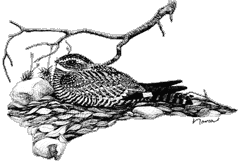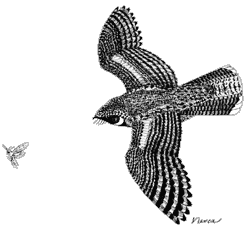Nightjars
Nightjars are birds of mystery. Camouflaged in mottled brown and gray, they generally hide and sleep during the day, resting on the ground or on horizontal branches with their big eyes closed. At night they emerge to fly about, as silent in the air as the moths that they often capture in their wide, gaping mouths. Many nightjars are best known by, and named for, their nocturnal songs; the Whip-poor-will, which reaches the mountain forests of the southwest, is a good example.
 |
Around rocky outcrops in the desert, the lonesome cry of the Poorwill is a familiar sound on summer nights, especially when the moon is bright. Naturalists who are out at night may find Poorwills sitting on roads, and may even be able to watch them hunt when the birds flutter up from the ground to catch passing insects. Poorwills mostly disappear from our region in winter, but they are not necessarily gone: these are the only North American birds known to hibernate, and they may sleep for days or even weeks at a time.
The Nighthawks (not related to hawks at all) are the most aerial of the nightjars, longer-winged and more buoyant in flight than their relatives. They are often seen flying about at dawn or dusk, or even in full daylight. The Lesser Nighthawk of the Southwest looks very much like the Common Nighthawk, widespread in North America, but the species differ in behavior. Common Nighthawks are flamboyant birds, flying high and calling loudly; but Lesser Nighthawks tend to fly low, and they usually maintain an eerie silence, floating like ghosts over the desert at dusk.
—Kenn KaufmanNightjars
Representative Sonoran Desert species:
 |
Lesser Nighthawk (Chordeiles acutipennis)
Common Poorwill (Phalaenoptilus nuttallii)
Order: Caprimulgiformes
Family: Caprimulgidae
Spanish names: tapacamino, garapena
Distinguishing Features
Both birds have large eyes, tiny bills, huge gapes, and short legs. Nighthawks are larger (8-9 inches; 20-23 cm) and are identified in flight by a white wing bar and pointed wings. Poorwills (7-8¼ inches; 17.5-21.5 cm) have rounded wings and no white bar.
Habitat
The Nighthawk and Poorwill are found in all Sonoran Desert habitats. The Poorwill is more common on sparsely vegetated bajadas.
Feeding
Both Nighthawks and Poorwills are insect-eaters, but their hunting techniques differ: the Nighthawk flies low, silently and gracefully, searching the sky for flying insects, and maneuvering quickly, almost like a bat. A hunting Poorwill sits on open ground, looking up into the sky for the backlit silhouettes of large moths or beetles. When it spots something, it flutters up, usually no higher than ten feet, and catches the insect in its mouth. Both birds are crepuscular, needing some light to hunt by. City lights may extend the activity of the more urban Nighthawk and also attract its prey. Lesser Nighthawks may also be seen until midmorning. Poorwills like hunting by moonlight (they’re lunarphilic) and on these nights they take over the niche of the lunar-phobic, insect-eating bat.
Life History
During the day, Lesser Nighthawks and Poorwills rest on the ground or horizontally on a branch, well camouflaged by their cryptic coloration. During winter, Lesser Nighthawks migrate, and Poorwills may too. But they may also hibernate, greatly l owering body temperature, respiration, and heart rates for days, even months, at a time. This behavior is very unusual in birds—hummingbirds enter torpor, but only for one night. The first documented hibernating Poorwill was found in the Sonoran Desert, in a hollow in a rocky canyon. Its discoverer tried to find signs of life in this apparently dead bird by catching the condensation of its breath on a mirror, but failed. Ten days later, the bird still hadn’t moved, but when the man touched it, the bird winked at him.










